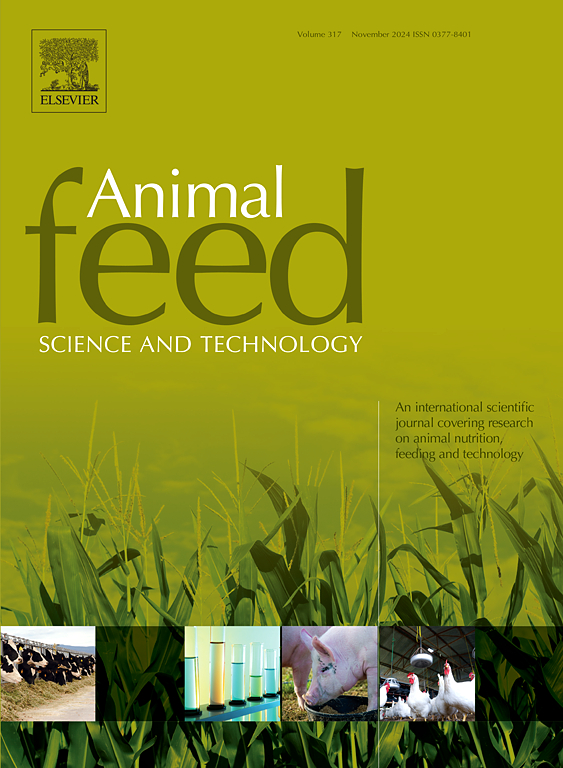三种饲喂系统中添加莫能菌素对肉牛生产性能、消化和瘤胃参数影响的meta分析
IF 2.5
2区 农林科学
Q1 AGRICULTURE, DAIRY & ANIMAL SCIENCE
引用次数: 0
摘要
本荟萃分析评估了在全混合日粮(TMR)、部分混合日粮(pTMR)和牧草等不同饲喂体系下,添加莫能菌素对肉牛生产性能、瘤胃参数和全消化道消化率的影响。该数据集包括131篇同行评审的出版物,其中包括349种治疗方法。利用对照组(不添加莫能菌素)和处理组(添加莫能菌素)之间的加权平均差异(WMD)来评估莫能菌素添加的效果。通过荟萃回归和亚组分析探讨异质性,其中考虑了动物固有的因素,如饮食,莫能菌素剂量和实验性状。添加莫能菌素降低(P <; 0.01)干物质采食量(DMI)(牧场:- 0.92 kg/d;pTMR:−0.12 kg/day, TMR:−0.25 kg/day)和平均日增重(ADG分别为0.06、0.05和0.02 kg/day)增加(P <; 0.01)。在pTMR系统中,遗传组和试验设计影响莫能菌素对瘤胃丙酸和丁酸浓度的影响(P <; 0.01)。此外,饲粮采食量和类型影响莫能菌素对饲料系数和瘤胃丙酸浓度的影响。在pTMR系统中,200-300 mg/d的莫能菌素摄入量促进了FCR的最大改善(WMD = - 1.07 kg/kg; = 0.011页)。在TMR系统中,遗传组、性别、育肥期、饲粮精料和粗蛋白质水平影响莫能菌素对DMI和ADG的影响(P <; 0.01)。饲料类型影响莫能菌素对日增重、乙酸、丁酸和异戊酸的影响(P <; 0.01)。在TMR饲粮中添加高达15 mg/kg DM的莫能菌素可改善饲料转化率(WMD = - 0.54 kg/kg;P = 0.001),平均日增重增加(WMD = 0.055 kg/天; = 0.001页)。因此,莫能菌素持续提高瘤胃丙酸浓度,改善肉牛生产性能和饲料效率,但这些反应的程度取决于每种饲养系统中的饲料、动物和实验因素。本文章由计算机程序翻译,如有差异,请以英文原文为准。
A meta-analysis of the effects of monensin supplementation on beef cattle performance, digestion and ruminal parameters in three feeding systems
This meta-analysis evaluated the effects of monensin supplementation on beef cattle performance, ruminal parameters, and total tract digestibility in different feeding systems, including total mixed ration (TMR), partial TMR (pTMR), and pasture. The dataset included 131 peer-reviewed publications that comprised 349 treatment means. The effects of monensin supplementation were evaluated using the weighted mean differences (WMD) between the control (diets without monensin) and treatment (diets with monensin) groups. Heterogeneity was explored through meta-regression and subgroup analysis, which considered factors inherent to the animal such as diet, monensin dose, and experimental traits. Monensin supplementation reduced (P < 0.01) dry matter intake (DMI) (pasture: −0.92 kg/day; pTMR: −0.12 kg/day, and TMR: −0.25 kg/day) and increased (P < 0.01) average daily gain (ADG, 0.06, 0.05 and 0.02 kg/day, respectively) in all feed systems. In the pTMR system, genetic group and experimental design influenced (P < 0.01) the effect of monensin on ruminal propionate and butyrate concentrations. Additionally, supplement intake and type affected the effect of monensin on feed conversion ratio (FCR) and ruminal propionate concentration. In the pTMR system, a monensin intake of 200–300 mg/day promoted the greatest improvement in FCR (WMD = −1.07 kg/kg; P = 0.011). In the TMR system, genetic group, sex class, fattening period, and dietary concentrate and crude protein levels influenced (P < 0.01) the effect of monensin on DMI and ADG. Forage type affected the effect of monensin on ADG, acetate, butyrate, and isovalerate (P < 0.01). Monensin inclusion of up to 15 mg/kg DM in TMR diets improved FCR (WMD = −0.54 kg/kg; P = 0.001) and increased ADG (WMD = 0.055 kg/day; P = 0.001). Thus, monensin consistently increased ruminal propionate concentration and improved beef cattle performance and feed efficiency, but the extent of these responses varied depending on dietary, animal, and experimental factors in each feeding system.
求助全文
通过发布文献求助,成功后即可免费获取论文全文。
去求助
来源期刊

Animal Feed Science and Technology
农林科学-奶制品与动物科学
CiteScore
6.00
自引率
6.20%
发文量
266
审稿时长
3 months
期刊介绍:
Animal Feed Science and Technology is a unique journal publishing scientific papers of international interest focusing on animal feeds and their feeding.
Papers describing research on feed for ruminants and non-ruminants, including poultry, horses, companion animals and aquatic animals, are welcome.
The journal covers the following areas:
Nutritive value of feeds (e.g., assessment, improvement)
Methods of conserving and processing feeds that affect their nutritional value
Agronomic and climatic factors influencing the nutritive value of feeds
Utilization of feeds and the improvement of such
Metabolic, production, reproduction and health responses, as well as potential environmental impacts, of diet inputs and feed technologies (e.g., feeds, feed additives, feed components, mycotoxins)
Mathematical models relating directly to animal-feed interactions
Analytical and experimental methods for feed evaluation
Environmental impacts of feed technologies in animal production.
 求助内容:
求助内容: 应助结果提醒方式:
应助结果提醒方式:


